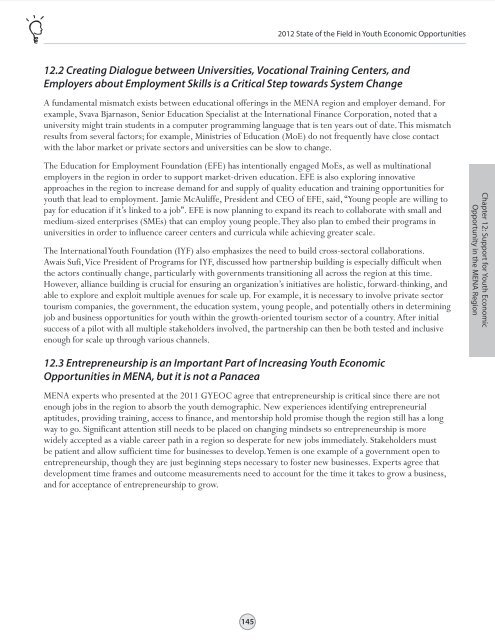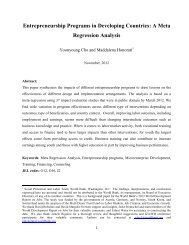STATE OF THE FIELD IN YOUTH ECONOMIC OPPORTUNITIES
STATE OF THE FIELD IN YOUTH ECONOMIC OPPORTUNITIES
STATE OF THE FIELD IN YOUTH ECONOMIC OPPORTUNITIES
Create successful ePaper yourself
Turn your PDF publications into a flip-book with our unique Google optimized e-Paper software.
Table of Contents<br />
Chapter 1 Chapter 2 Chapter 3 Chapter 4 Chapter 5 Chapter 6 Chapter 7 Chapter 8<br />
Chapter 9<br />
Chapter 10 Chapter 11 Chapter 12 Chapter 13 Chapter 14 Chapter 15 Annexes<br />
2012 State of the Field in Youth Economic Opportunities<br />
12.2 Creating Dialogue between Universities, Vocational Training Centers, and<br />
Employers about Employment Skills is a Critical Step towards System Change<br />
A fundamental mismatch exists between educational offerings in the MENA region and employer demand. For<br />
example, Svava Bjarnason, Senior Education Specialist at the International Finance Corporation, noted that a<br />
university might train students in a computer programming language that is ten years out of date. This mismatch<br />
results from several factors; for example, Ministries of Education (MoE) do not frequently have close contact<br />
with the labor market or private sectors and universities can be slow to change.<br />
The Education for Employment Foundation (EFE) has intentionally engaged MoEs, as well as multinational<br />
employers in the region in order to support market-driven education. EFE is also exploring innovative<br />
approaches in the region to increase demand for and supply of quality education and training opportunities for<br />
youth that lead to employment. Jamie McAuliffe, President and CEO of EFE, said, “Young people are willing to<br />
pay for education if it’s linked to a job”. EFE is now planning to expand its reach to collaborate with small and<br />
medium-sized enterprises (SMEs) that can employ young people. They also plan to embed their programs in<br />
universities in order to influence career centers and curricula while achieving greater scale.<br />
The International Youth Foundation (IYF) also emphasizes the need to build cross-sectoral collaborations.<br />
Awais Sufi, Vice President of Programs for IYF, discussed how partnership building is especially difficult when<br />
the actors continually change, particularly with governments transitioning all across the region at this time.<br />
However, alliance building is crucial for ensuring an organization’s initiatives are holistic, forward-thinking, and<br />
able to explore and exploit multiple avenues for scale up. For example, it is necessary to involve private sector<br />
tourism companies, the government, the education system, young people, and potentially others in determining<br />
job and business opportunities for youth within the growth-oriented tourism sector of a country. After initial<br />
success of a pilot with all multiple stakeholders involved, the partnership can then be both tested and inclusive<br />
enough for scale up through various channels.<br />
Chapter 12: Support for Youth Economic<br />
Opportunity in the MENA Region<br />
12.3 Entrepreneurship is an Important Part of Increasing Youth Economic<br />
Opportunities in MENA, but it is not a Panacea<br />
MENA experts who presented at the 2011 GYEOC agree that entrepreneurship is critical since there are not<br />
enough jobs in the region to absorb the youth demographic. New experiences identifying entrepreneurial<br />
aptitudes, providing training, access to finance, and mentorship hold promise though the region still has a long<br />
way to go. Significant attention still needs to be placed on changing mindsets so entrepreneurship is more<br />
widely accepted as a viable career path in a region so desperate for new jobs immediately. Stakeholders must<br />
be patient and allow sufficient time for businesses to develop. Yemen is one example of a government open to<br />
entrepreneurship, though they are just beginning steps necessary to foster new businesses. Experts agree that<br />
development time frames and outcome measurements need to account for the time it takes to grow a business,<br />
and for acceptance of entrepreneurship to grow.<br />
145

















